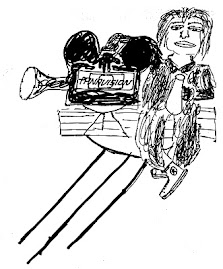“Night Flight” viewers in early 1984 got a lot of laughs from watching the racy and politically incorrect music video for Mel Brooks’ “The Hitler Rap.” They may not have realized they were watching an historical trailblazer, as Brooks’ song was not only an unlikely hit single, it wasn’t even his first time as a rap star!
In late 1981, shortly after the release of his comedy History Of The World, Part I, Mel Brooks joined with producer/songwriter Pete Wingfield, and together, using the running catchphrase uttered by Brooks as Louis XVI in the film, they created the single “It’s Good to Be the King.”
In the persona of the monarch, Brooks raves about living large in the days before the French Revolution claimed his head.
The single was put out in 1982 by Philadelphia soul label WMOT Records, best remembered for releasing Frankie Smith’s “Double Dutch Bus.”
The song received heavy rotation on New York station WBLS, and, while it did not enter the Billboard Top 100, it reached #67 on the Billboard Dance music chart and #69 on Billboard’s R&B chart.
Thus, Brooks became the first white artist performing a full-fledged rap song to penetrate the R&B chart, a feat that would not be repeated until the Beastie Boys reached #55 with “Hold It Now, Hit It” in 1986.
In France, “It’s Good to Be the King” was an even bigger smash, selling 375,000 copies and going all the way to #2 on their equivalent SNEP chart.
Most strikingly, in the tradition of rap hits like UTFO’s “Roxanne Roxanne” and M.C. Shan’s “The Bridge,” Brooks’ surprise hit provoked an answer record, from the very woman who helped put hip-hop in the American consciousness.
Sylvia Robinson, founder of Sugarhill Records, the label that launched the Sugarhill Gang and their immortal “Rapper’s Delight,” recorded her own reworded version of the song called “It’s Good to Be the Queen,” which surpassed Brooks’ single on the Billboard R&B chart, reaching #53. Robinson also invited Brooks’ writer/producer Wingfield to collaborate with her, and together they wrote “The Lover in You” for the Sugarhill Gang, with Wingfield playing keyboard and singing back-up, which went to #55 on the R&B chart.
In 1983, to promote the film To Be or Not to Be, starring Brooks and his wife Anne Bancroft, and directed by his longtime choreographer Alan Johnson, Brooks and Wingfield reteamed to record “To Be or Not to Be” (the actual title for “The Hitler Rap”), using roughly the same melodic structure and comedic principle of Brooks in character bragging about the good life until history brought him down.
To promote both the film and the single, Brooks and his director/choreographer Alan Johnson made an accompanying video, featuring Brooks as Hitler, rapping and (through a body double) even breakdancing, while scantily clad dancers engaged in sexy moves designed by Johnson.
While some outlets chose not to air the clip due to its Nazi imagery and suggestive poses, the clip got substantial play on “Night Flight” as well as BET’s “Video Soul” program, and was screened in European cinemas as a short subject.
Chris Blackwell’s Island Records released the single worldwide, though in the U.S. it was handled by its independent subsidiary Antilles.
While only receiving a modicum of novelty success in America, “To Be or Not to Be” was a substantial hit in other English-speaking countries. The song went to #12 on the UK Singles chart, and all the way to #3 on the Australian Pop chart.
The video was later included in a Vestron Video Comedy Music Videos compilation tape alongside other frequent “Night Flight” favorites like Garry Trudeau’s “Rap Master Ronnie” and the Fat Boys’ “Jailhouse Rap.”
While Brooks, who recently marked his 90th birthday, long left hip-hop behind to concentrate on creating musical stage versions of his classics The Producers and Young Frankenstein, his brief sojourn continues to garner respect.
In an article on the history of white comedians’ use of rap, Brian Raftery of Vulture declared, “[What’s] most surprising about ‘Hitler Rap’ is that it’s not awful. Brooks has a decent enough flow, and he’s smart enough not to wink the joke to death.”
His earlier single received significant homage from the French mixed-race rap group Alliance Ethnik in their 1995 song “Respect”: the melodic background is a variation of the riff Wingfield created for “It’s Good to Be the King,” and the phrase is openly referenced at 3:13.
As such, history can safely say that by not only being a king of comedy, but also preceding Eminem and The Beastie Boys in earning the respect of the community that created rap music, it’s good to be Mel Brooks!
(This essay was originally written for Night Flight Plus. It has been recreated in the style it was presented in at the site, and matched to its original date of publication. Tremendous thanks to Stuart Shapiro and Bryan Thomas for the platform.)
























































